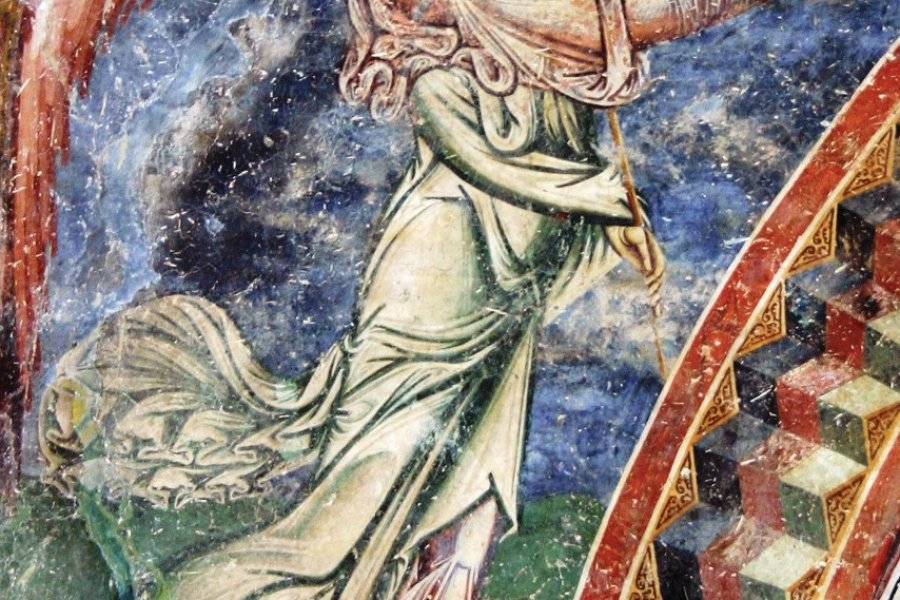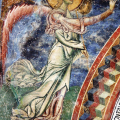ST. GORGES CHURCH OF KURBINOVO (СВЕТИ ЃОРЃИ КУРБИНОВО ВО ЦРКВА)
This Byzantine church houses some of the country's most precious frescoes. After a major restoration campaign conducted in 2014-2015, it is again open to the public. Built at the end of the twelfth century, it was the Catholic catholicon (main church) of the monastery Saint-Georges whose rest of the buildings has now disappeared. Its frescoes are dated 1191 - at the level of the abside, an inscription indicates that the painters began their work on April 25 of that year. They are considered one of the finest examples of the Byzantine art of the twelfth century. A rather classic bill, mixing Constantinopties' constantinopties and "provincial" particularisms, is, according to researchers, an «extreme outcome» of the great artistic movement of the Comnenos dynasty (1081-1185), which is influenced by influences to the wall paintings of Notre-Dame du Puy Cathedral. -en Velay (Upper Loire). The frescoes of the frescoes remain anonymous. But the scope of these works is such that the management is assigned to an artist named the «great master of Kurbinovo». He was probably from a workshop of the prestigious painting school in Kastoria (now in Greece). Moreover, there are several commonalities here with some churches in this city, including the frescoes of the church of Saints-Anargyres made between the eleventh and twelfth centuries.
Building. From the outside, the church looks like a farm. It is a rectangular building (17 x 7 m) built in stone with some brick knives. It is the largest single nef church in the country, with a semi-circular abbey. It has undergone some changes in the 1920 s: addition of a porch and a wooden ceiling, closure of south and north-transformed entries into windows. Located on the hill and surrounded by trees, it offers a beautiful panorama on the lake. The main entrance is west. A second door was preserved on the south side. The walls retain a few fragments of frescoes outside the twelfth and sixteenth century. On the west façade, under the porch, some of the portraits carried out in the twelfth century: those of Saint George, patron of the church, as a rider with the saints Theodore and Demetrios also on horseback, donors (doubtless a couple of nobles Byzantine), Isaac II Ange (last Byzantine emperor before taking Constantinople by the crusades in 1204), of his wife l Empress Marguerite de Hungary and Jean V Kamateros, Archbishop of Ohrid from 1183 to 1216. The interior walls of 5 m height are entirely covered with frescoes with the exception of some lost parts, particularly on the west wall and all upper areas. The church does not have iconostasis or value icons.
Frescos of the abbey. The wall is, opposite the main entrance, is decorated with the most important and best preserved frescoes of the church. It is a large set divided into three areas. The frontal, above the absidian conch, hosts the scene of Pentecost, revelation of the Holy Spirit to the apostles fifty days after Easter: Christ in the majesty (severely damaged) appears to the Mother of God surrounded by archangels Gabriel and Michel, then apostles distributed on both sides. The conch itself develops the theme of the Annonunciation, that is, the announcement made to Mary of his divine motherhood by the archangel Gabriel. The Mother of God presents the child Jesus as a symbol of the Lamb of God (sacrificial victim). It is once again framed with archangels Gabriel (to g.) and Michel. This representation of Gabriel, nicknamed «the angel of Kurbinovo», is the church's most famous fresco and appears on the 50-denar banknotes of the Republic of Macedonia. On both sides of the conque appear, Gabriel and Mary. Finally, at the altar and side walls are painted the portraits of the Fathers of the Church, but also of Saint George, Saint Erasme, the two evangelizers Cyril and Methoril and their disciple Clément d 'Ohrid, Saint Achille de Larissa (patron saint of Bulgarian czar Samuel), as well as Pope Clement III (last bishop of Rome to have tried to avoid the schism of 1054). In addition to its stylistic quality (balance of composition, body flexibility, rendering of drapes), this cycle of frescoes contains exemplary elements both at the political level (the Bulgarian heritage, relations with Rome) and iconographical with the oldest fresco of St. Méthode and the unique portrait of Ohrid realized in the twelfth century. Finally, this is the first time in Byzantine iconography that the amour - theme of the Lamb of God - is represented thus, surrounded by representatives of the Church, heaven and earth, which will be subsequently standardized.
Frescos on the south wall. On the right side of the main entrance, the south wall is decorated with the round of the Great Orthodox Holidays (Nativity, baptism of Christ, etc.). Among them, one of the most important frescoes is the double stage of Visitation. It is located at the angle of the angle with the east wall (abside). The episode takes place after that of the Annonunciation: Mary, who has just learned that she was pregnant with Christ, is part of his cousin Elisabeth, herself pregnant by six months of Jean-Baptiste, last of the prophets of the Old Covenant. In the first stage, young Mary found Elizabeth, a tired, tired old woman. They stretch and kiss. The second stage, on the right and partly erased, illustrates the last three months of Elizabeth's pregnancy during which both women will stay together. It is above all the scene of the reins that is moving, illustrating the complicity of motherhood that unites both cousins. Such effusion of feelings is rarely represented in Christian art. The painter has entered the Greek term "kisses" (ασπασμtudes ζ/aspasmos) above the two women. This aspect particularly touching one of the scenes of the most famous Visitation of Christian iconography. The theme of maternity is also addressed, always on the southern wall, in the lower area, near the door, with this very rare breastfeeding scene: Mary's mother, Sainte Anne, giving Mary breast. A similar fresco of the thirteenth century exists in the Agios Stefanos metropolitan church of Kastoria, which attests to the links between Kurbinovo and the great Greek school.
Other frescos. The west wall (main entrance) is also very richly decorated. The frontal is dominated by the Pantheon of saints, incompletely preserved. Above all, this is where the Grand Holidays cycle started on the south wall and the Passion of the North Wall. Among the most striking scenes, we must note the Ascension (Jesus rises in heaven, after being placed on the cross) with Christ providing the living waters (symbol of the Holy Spirit and eternal life) surrounded by the Virgin and Jean-Baptiste, the entry of Christ into Jerusalem, the Transfiguration (revelation) of the divine nature of Christ to apostles Peter, Jacques, and Jean), the Dormition of the Mother of God, the Last Judgment, the Theophania of the Ancient Days (divine revelation of the coming of Messiah) marked by the presence of cherubins, sprochins andangels, etc. Among the details, note Saint Marina beating Belzébuth, a scene found twice at the Ohrid Icons Gallery. Finally, on the north wall, among the scenes of the Passion cycle, one detached those from the Crucifixion and the Lamentations. In the lower area of the northern wall, the great portrait of Saint George responds to that of Christ symbolizing the Peace of the South Wall.
Did you know? This review was written by our professional authors.
Members' reviews on ST. GORGES CHURCH OF KURBINOVO (СВЕТИ ЃОРЃИ КУРБИНОВО ВО ЦРКВА)
The ratings and reviews below reflect the subjective opinions of members and not the opinion of The Little Witty.



